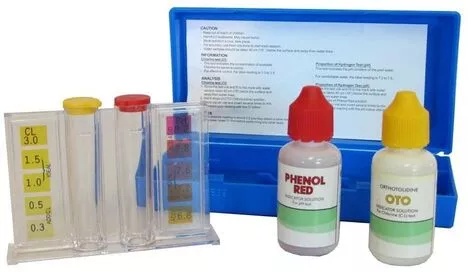test your water at home kit
test your pool water
How to test your pool water the right way
The best water quality test kit for your home
Comprehensive test, visible results
Swimming pool water quality test before use To practice swimming and have fun is the best kind of sport The test is carried out using a solution intended for chlorine and another to measure the percentage of acids,
ph Swimming pool water test test your water at home kit
Frequently testing the pool water is essential to keeping the pool and your family healthy. Maintaining a balance of water chemicals is important to your pool, pool equipment, its working efficiency, and its longevity as a whole.
Having an accurate water chemistry reading will help you understand how much of the specific chemicals you need in the pool to perform the necessary water treatment.
Regular testing of pool water prevents the possibility of insufficient treatment and over-treatment of the water.
We advise through our experience
Regular testing in a continuous way will save you from excessive water treatment, which costs you a lot of money! And use only the chemicals the pool really needs. This blog will explain
A video of the basics of water testing. We want to help our customers become more confident in their water testing and enjoy healthy, balanced pool water all the time.
Swimming pool water test with liquid. or pool water test strips
Testing your pool water is fairly simple, if you have the right tools and know what to use them and what to do with them. If you are testing at home, we recommend using a test kit or test strips. Below we’ve outlined the benefits of using each type of test, as well as certain things to watch out for with each test.
liquid test
benefits
The most accurate type of test; Especially for chlorine test
✓ Allows you to test and examine more accurate water chemistry
The most common and recommended type of home test
I notice
Testing can take a little longer
Dropper bottles must be hung properly and carefully counted when they leak
Do not touch the tip of dropper bottles as this can cause the tests to run off and contaminate the droplets
Do not switch dropper bottle caps
Tips to test pond water!
Always try to keep essential pool chemicals on hand. If you need a quick water treatment, you don’t have to go to the store from time to time or order products.
Please keep a primary sanitizer on hand (chlorine and acid) to kill viruses and bacteria in your pool water. Plus, keeping a weekly shockwave on hand ensures that the sanitizer works as efficiently as possible. We also recommend keeping water balancers to control pH, total alkalinity, and calcium hardness. Furthermore, we recommend that you keep the algicide, neutralizer, and filter as well. And also Ga Syed and Fluke Asad!
For the most accurate pool water test results
Carefully follow all instructions that come with the test products.
Most water tests include measuring available chlorine, pH, total alkalinity, and cyanuric acid. If your pool has a salt system, the salt level should also be checked.
Or the presence of a percentage of the element iron.
When using a test set, please take the water sample 12 to 18 inches below the surface after the filtration cycle system has been running for two hours. A good rule of thumb is to take a sample of the water from the depth of the elbow in the pool water.
For test strips, dip the strip according to the attached directions.
The ideal test is as follows: Chlorine: 2.0-4.0ppm, pH: 7.4-7.6, total alkalinity: 80-120ppm, calcium hardness: 200-400ppm, cyanuric acid: 30-50ppm The millionth.
Elevated chlorine levels can interfere with other readings, such as pH and total alkalinity. If high levels of chlorine are present, a chlorine neutralizer should be added to the pool water.
It may take some time for some test reactions to occur. Know the instructions before using any type of water test.
Store all test materials in a cool, dark area (such as a shed or garage), and check for accuracy on a yearly basis. Expired test materials can cause inaccurate readings!
Water tests should always be completed before any chemicals are added
The amount of chemical to add is found on the individual label based on the size of your pool and what your level is. As for salt, almost all manufacturers have a chart in their guide on how much salt to add to their system, based on your level.
When adding salt, the salt should be added slowly over time. For example, if your regimen requires 4 sachets, start with 2 and add more gradually. This is to prevent false salt readings and over-salting your pool.
After adding the chemicals, it is important to let the water circulate completely before testing the water again. This process typically takes about 12 to 24 hours for most pools, but the timing depends on pump size, runtime, and pool size.

